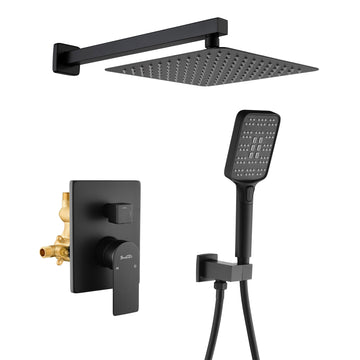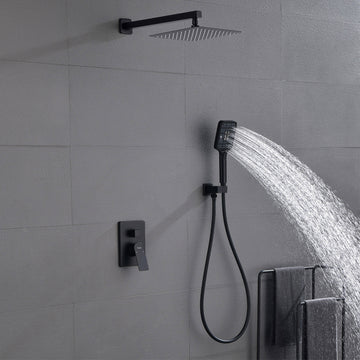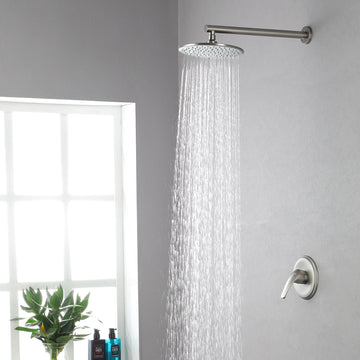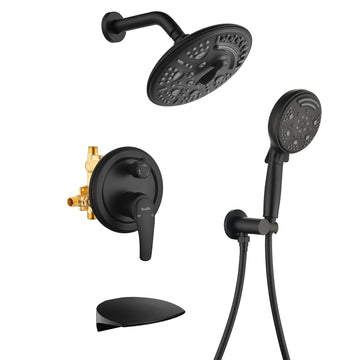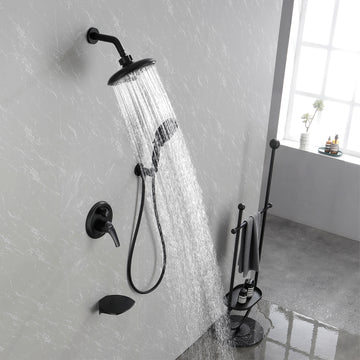How to tell if a bathroom faucet is right for your sink?
When choosing a new bathroom faucet, many people focus solely on the design and overlook the importance of proper fit. An ill-fitting faucet not only affects aesthetics but also causes numerous inconveniences during daily use—splashing, difficulty washing hands, and difficulty cleaning. This article will provide step-by-step guidance on how to scientifically determine the compatibility of a faucet, ensuring you purchase a perfect product that is both aesthetically pleasing and practical.
I. The "Golden Ratio" Rule for Faucets and Sinks
- 1. Height Matching
✨ Above-Counter Basins: The faucet should be installed 5-10cm (2-4 inches) above the sink rim.
For example: If your above-counter basin is 15cm (6 inches) high, choose a faucet with a total height of 20-25cm (8-10 inches).
✨ Under-Counter Basins: The spout should be 3-5cm (1-2 inches) above the sink rim.
✨ Pedestal Basins: Choose a dedicated high-height faucet (usually 30-45cm) (12-18 inches).
- 💡 Pro Tip: Use a tape measure to measure the vertical distance from the mounting surface to the desired water flow point. This value will determine the desired faucet height.
- 2.Key Indicators for Water Outlet Extension
The outlet point should be located in the center of the sink (with a tolerance of no more than 5cm [2 inches]).
Extension Length Calculation Formula:
Minimum Extension Length = (Sink Width / 2) - Distance from Mounting Hole to Sink Edge
Example: For a 60cm (24-inch) wide sink with the mounting hole 10cm (4 inches) from the edge, the extension should be at least (60/2) - 10 = 20cm [(24/2) - 4 = 8 inches].
- 3. "Three Checks" for Mounting Hole Location
✅ Check Quantity: Single/Triple/Quadruple Holes
✅ Check Spacing: 8cm [3 inches] (European Standard) or 15cm [6 inches] (US Standard)
✅ Check Hole Diameter: Generally 3-4cm [1-1.5 inches] (measure the inside diameter of the existing hole).
II. 5-Step Quick Diagnosis: Determine if Your Existing Faucet is Suitable
- Step 1: Perform the "Splash Test"
Turn on full water flow and observe:
Ideal: Water flows vertically into the drain
Needs adjustment: Water hits the basin wall or lands on the countertop - Step 2: Perform the "Handwashing Simulation"
Using normal handwashing movements, check:
* Is it easy for your hands to touch the faucet?
* Is it necessary to bend over or raise your arms? - Step 3: Measure the "Safety Distance"
Maintain a 5cm (2-inch) minimum distance between the highest point of the faucet and the mirror cabinet/wall.
Maintain a 10cm (4-inch) minimum distance between the rotating parts and other objects. - Step 4: Check for "Blind Spots"
Can your fingers easily reach around the faucet base?
Is there ample clearance around the basin joint? - Step 5: Assess "Functional Compatibility"
Deep sinks (>15cm) [>6 inches]: Choose a high-arc model
Small basins (<40cm) [<16 inches]: Consider a short spout or wall-mounted model
III. Key Considerations for Choosing Different Sink Types
- Above-Counter Basin Solutions
Recommended Style: High-Neck Single-Lever Faucet
Tip:
Avoid models with a base diameter greater than 12cm (>5 inches) (difficult to clean).
Confirm the countertop opening location (center/backward). - Under-Counter Basin Compatibility
Best Choice: Low-Profile, Wide-Angle Swivel Faucet
Key Stats:
Spout Angle ≥ 45°
Swivel Radius ≥ 15cm (6 inches) - Considerations for Odd-Shaped Basins
Round Basins: Ensure 360° swivel capability.
Oval Basins: Choose a model with adjustable water flow direction.
Double Basin Design: Consider dual outlets or a pull-out faucet.
IV. Tips for Verifying Faucet Sizes When Buying Online
- Make a Paper Model
Print a 1:1 ratio outline based on the dimensions on the product details page
Build a 3D cardboard model for field testing - Ask customer service the following three essential questions:
Vertical height from mounting surface to spout
Horizontal extension of spout
Minimum installation space required for base
V. Acceptance Criteria After Professional Installation
✅ Water Flow Test: No splashing at maximum water flow
✅ Operation Test: Handle rotates without hitting any obstructions
✅ Cleaning Test: The base of the faucet can be easily wiped clean
✅ Visual Test: Proportions are balanced from a primary viewing angle
✅ Functional Test: All additional functions (such as pull-outs) function properly
VI. Emergency Solutions for Common Problems
- Problem: Faucet is too short after installation
→ Remedial Measures:
✨ Install an extender (reduced aesthetics)
✨ Replace the spout with an adjustable angle
✨ Adjust the installation position (requires professional assistance)
- Problem: Water flow is off-center
→ Adjustment Method:
✨ Rotate the faucet body (adjustable models only)
✨ Add a spacer to change the angle
✨ Replace the spout with a different extension length

Conclusion: The Three Golden Standards for a Perfect Fit
🌟 Functionality: Water flows precisely into the drain area, allowing for a natural user posture
🌟 Aesthetics: Harmonious with the bathroom style and perfectly proportioned
🌟 Maintenance: Easy to clean, eliminating any hidden corners
Remember, a truly well-fitting faucet should be completely invisible when in use—no need to adjust to its height, worry about splashing, or find yourself in hard-to-reach spots when cleaning. Taking the time to match the faucet's dimensions properly will significantly enhance your bathroom experience.























